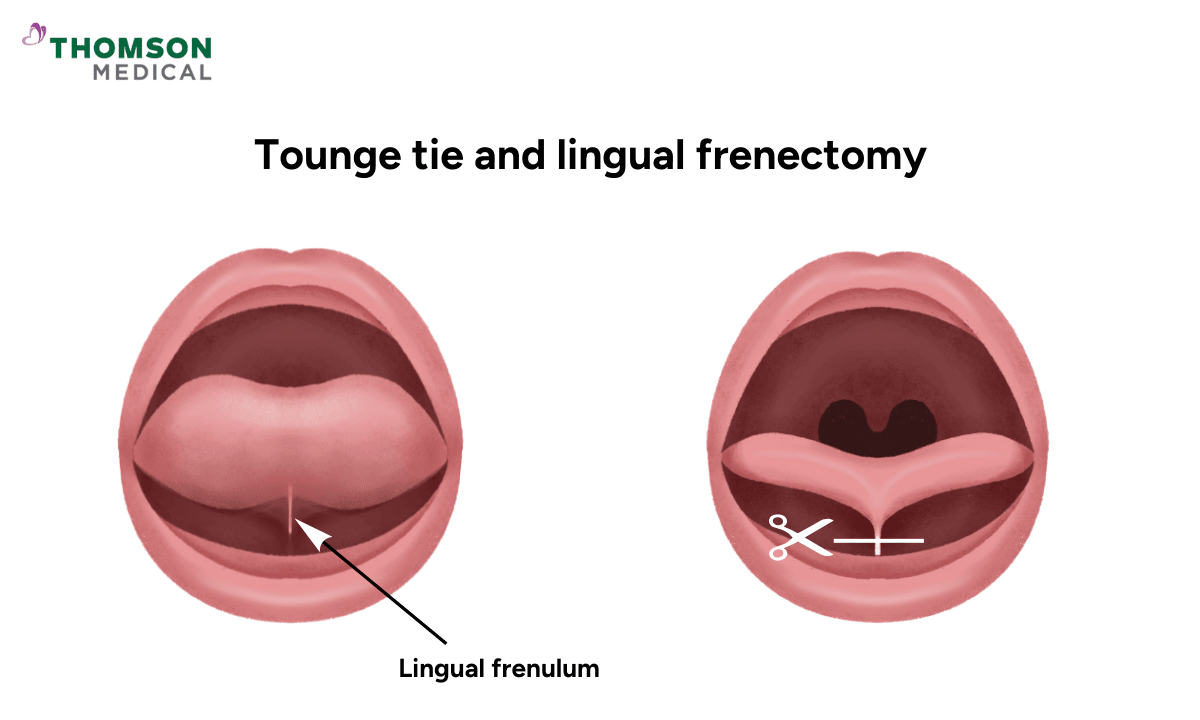When a doctor mentions "tongue tie", you might worry about what this means for your child's development. It could mean that your baby is struggling to latch during breastfeeding, or perhaps your child's speech seems unclear compared to other children their age.
The good news is that tongue tie is a common condition that can be identified and treated. Let's explore what's happening and what treatment options, such as a frenectomy, can help your child thrive.
What is a tongue tie?
A tongue tie, known medically as ankyloglossia, is when the lingual frenulum (the small tissue connecting the tongue’s underside to the mouth floor) is unusually short, thick, or tight.
This can restrict the tongue's range of motion and lead to various issues, such as feeding problems and speech difficulties.
What is a frenectomy?

A frenectomy involves removing or modifying a frenulum (a small fold of tissue restricting organ movement). In the context of oral health, a frenectomy is a relatively straightforward procedure that usually refers to treating ankyloglossia (tongue tie) or a restrictive labial frenulum (lip tie).
Types of frenectomy
Depending on which tissue is tight and how it affects your child’s feeding, speech, or oral comfort, there are different types of frenectomy. Each procedure is designed to remove the restriction and restore more natural movement.
Lingual frenectomy
Lingual frenectomy releases a tongue tie, where the lingual frenulum is too tight, affecting tongue movement, breastfeeding in infants, speech problems in children or adults and oral hygiene issues.
Labial frenectomy
Labial frenectomy addresses the lip tie, where the labial frenulum (connecting the upper lip to the gum) is tight and restricts lip movement, causing breastfeeding difficulties, gaps between the front teeth and irritation or pain.
Frenectomy surgical procedure

Hearing about a procedure can feel anxious, especially when it involves your child. Taking the time to understand what to expect during a frenectomy can help you feel calmer and more prepared.
Consultation
During the consultation, a dentist, paediatrician, or specialist determines your child’s need for a frenectomy, followed by a discussion of medical history and symptoms.
Preparation
Local anaesthesia is typically used to numb the area, especially in older children and adults, though for infants, topical anaesthetics may be sufficient.
Surgical techniques
There are a few different techniques available, and your doctor will recommend the most suitable option based on your child’s condition, age, and overall comfort.
Traditional methods:
Your child’s doctor usually uses a scalpel to cut the frenulum.
Laser frenectomy:
A laser is used to cut and cauterise the tissue, which can reduce bleeding and speed up healing.
Electrosurgery:
This method uses an electric current to cut tissue and control bleeding.
Post-procedure care
Post-care may include prescribed pain relievers, oral hygiene guidance, surgical site care and gentle stretching exercises to prevent the frenulum from reattaching too tightly during healing.
If you’re wondering whether your child truly needs a frenectomy or which type of procedure may be most suitable, our paediatric dentists are here to help. Schedule an appointment to discuss your child’s feeding, speech, or oral concerns and receive personalised advice tailored to his needs.
Our paediatric dentists
Loading...
Frenectomy recovery and aftercare
Recovery after a frenectomy is usually straightforward, and most children bounce back quickly with the right care and reassurance. Initial healing typically takes about 1–2 weeks, though complete healing may take a little longer depending on your child’s age and overall health.
During this time, you can help support healing by keeping things gentle and comfortable:
Diet:
Offer soft foods and cool drinks to minimise discomfort.
Avoid spicy, acidic, or hard foods that may irritate the area while it heals.
Oral hygiene:
Gently brush your child’s teeth and rinse using a prescribed mouthwash or mild saltwater.
Avoid vigorous rinsing, as this may disturb the healing tissue.
Follow-up care:
Attend follow-up appointments to make sure healing is progressing well.
Your doctor may recommend speech therapy to help your child make the most of their improved tongue or lip movement.
If you have any questions during your child’s recovery or would like guidance on healing, feeding, or speech support after a frenectomy, schedule an appointment with Thomson Medical. Our paediatric dentists will make sure your child is healing well and moving forward with comfort and confidence.
FAQ
Do tongue ties need to be fixed?
Not always. Some tongue ties cause no problems at all. Treatment is usually recommended only if the tongue tie is affecting feeding, speech, or oral comfort.
At what age does a tongue tie go away?
A tongue tie does not usually disappear on its own. However, as children grow, some may adapt and have fewer symptoms, while others continue to experience difficulties.
How to correct a tongue tie?
If treatment is needed, a frenectomy can gently release the tight tissue. The procedure is quick, and your doctor will recommend it only when it’s likely to benefit your child.
Does a tongue tie come from your parents?
Tongue tie characteristics can run in families, so genetics may play a role. It’s not caused by anything a parent did during pregnancy.
What are the potential risks and complications of a frenectomy?
Frenectomy is generally very safe. Mild swelling, minor bleeding, or temporary discomfort can occur, but serious complications are rare when performed by an experienced specialist.
How is a frenectomy beneficial?
Releasing the tongue tie can improve breastfeeding, support clearer speech, and make everyday oral movements more comfortable. For many children, it leads to easier feeding and better overall function.
The information provided is intended for general guidance only and should not be considered medical advice. For personalised recommendations and advice based on your unique situation, please consult a specialist at Thomson Medical. Request an appointment with Thomson Medical today.
